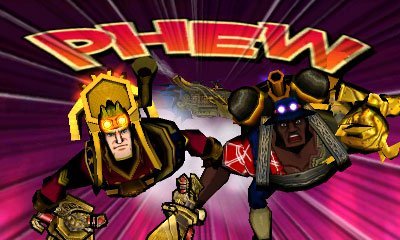What happens when smart developers tackle new IP?
When I was first introduced to Codename S.T.E.A.M. I kind of ignored it because I wasn’t sure what to make of the experience as a totally new license created in-house at Nintendo. While Intelligent Systems is known for both Advanced Wars and Fire Emblem, I think I was hopeful we would get to see a new Metroid title and S.T.E.A.M.’s premise proved nothing less than unique. In fact, the acronymic name alone seemed like a bit of a turn-off.
In Codename S.T.E.A.M. players find themselves in control of a patriotically-themed fighting force equipped with steam-powered weaponry that launches, blasts, and generally acts as strategic move-currency. Run out of steam and you’re likely to lose a match against the alien menace. If you’re like me, you’re still confused and for some reason you’ve been blessed with an opportunity to play the game early… for work… you know. Like it’s your job or something.
Codename S.T.E.A.M. had a big showing at Nintendo’s showcase event at the start of this year and with it came quite a few answers to the questions dedicated gamers will want to hear. For example, why all the patriotism? Apparently, the Strike Team Eliminating the Alien Menace has organized to defend London from alien attack, but more importantly this is a damn deep strategy game.
While Advanced Wars and Fire Emblem provide top-down views of the battlefield, Codename S.T.E.A.M. forces the player to consider the boots on the ground particularly because you’re always looking at the action from that perspective. You won’t be able to spot enemies if you don’t play cautiously, but you’ll likely learn a lot of the mechanics faster if you give it your best and leave room for failure. The class-balancing and unit management of other Intelligent Systems franchises doesn’t look or feel the same with Codename S.T.E.A.M.’s third-person shooter combat.
An air rifle may have higher accuracy, but it could also do less damage. Using one of the character’s pouncing abilities will close the gap with enemies, but could leave him or her vulnerable to damage. A healer character may want to stay towards the back, but a secondary weapon could provide strong offensive opportunities. Balancing all of these factors makes Codename S.T.E.A.M. feel like XCOM: Enemy Unknown in a great way.
Luckily, the game doesn’t rest on 2K Games and what’s been established in the genre. Overwatch firepower doesn’t require a dedicated turn in Codename S.T.E.A.M. and the battlefield layout appears to be denser in this 3DS strategy game. Rather than spotting enemies within range, I had to look around corners and around shipping containers. Breaking open some of the decorations for collectibles meant either health or steam energy, but I couldn’t rely on what was left behind following a destructive sequence of moves.
Instead, I did my best to flank enemy units. With the setting and characters dripping with gorgeous comic book style and a unique departure for Nintendo’s narrative teams, it’ll be more satisfying to unlock new characters and learn about those you’ve used as you progress. As much as I’d like to go into far more extensive detail, it’s hard to describe exactly what Codename S.T.E.A.M. does differently without spoiling discovery within gameplay. That facet of the medium seems lost in sequelization and having expectations leading into a new IS development project adds to the overall effect on the player here.
I know it’s silly to continue calling back to Fire Emblem and Advanced Wars in reference to S.T.E.A.M. but it’s the best way to share what’s needed without playing the game yourself. We’ll have more on the title leading up to its release on March 13th, 2015. Click here for more coverage of this month’s big Nintendo event. For another take on how Codename S.T.E.A.M. offers up a different strategic method of attack, click here.







